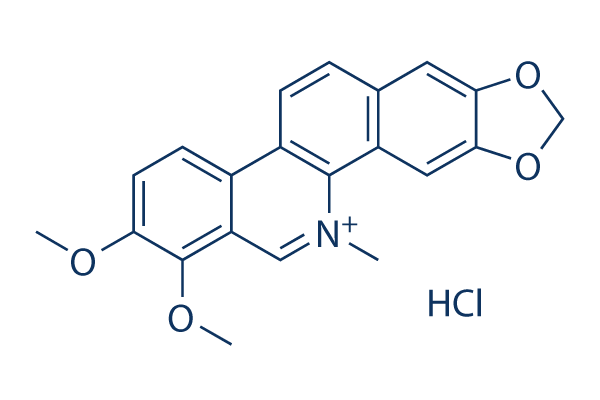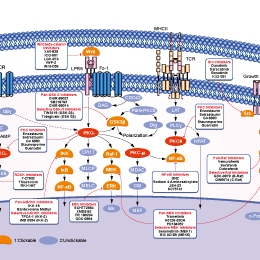
- Bioactive Compounds
- By Signaling Pathways
- PI3K/Akt/mTOR
- Epigenetics
- Methylation
- Immunology & Inflammation
- Protein Tyrosine Kinase
- Angiogenesis
- Apoptosis
- Autophagy
- ER stress & UPR
- JAK/STAT
- MAPK
- Cytoskeletal Signaling
- Cell Cycle
- TGF-beta/Smad
- DNA Damage/DNA Repair
- Compound Libraries
- Popular Compound Libraries
- Customize Library
- Clinical and FDA-approved Related
- Bioactive Compound Libraries
- Inhibitor Related
- Natural Product Related
- Metabolism Related
- Cell Death Related
- By Signaling Pathway
- By Disease
- Anti-infection and Antiviral Related
- Neuronal and Immunology Related
- Fragment and Covalent Related
- FDA-approved Drug Library
- FDA-approved & Passed Phase I Drug Library
- Preclinical/Clinical Compound Library
- Bioactive Compound Library-I
- Bioactive Compound Library-Ⅱ
- Kinase Inhibitor Library
- Express-Pick Library
- Natural Product Library
- Human Endogenous Metabolite Compound Library
- Alkaloid Compound LibraryNew
- Angiogenesis Related compound Library
- Anti-Aging Compound Library
- Anti-alzheimer Disease Compound Library
- Antibiotics compound Library
- Anti-cancer Compound Library
- Anti-cancer Compound Library-Ⅱ
- Anti-cancer Metabolism Compound Library
- Anti-Cardiovascular Disease Compound Library
- Anti-diabetic Compound Library
- Anti-infection Compound Library
- Antioxidant Compound Library
- Anti-parasitic Compound Library
- Antiviral Compound Library
- Apoptosis Compound Library
- Autophagy Compound Library
- Calcium Channel Blocker LibraryNew
- Cambridge Cancer Compound Library
- Carbohydrate Metabolism Compound LibraryNew
- Cell Cycle compound library
- CNS-Penetrant Compound Library
- Covalent Inhibitor Library
- Cytokine Inhibitor LibraryNew
- Cytoskeletal Signaling Pathway Compound Library
- DNA Damage/DNA Repair compound Library
- Drug-like Compound Library
- Endoplasmic Reticulum Stress Compound Library
- Epigenetics Compound Library
- Exosome Secretion Related Compound LibraryNew
- FDA-approved Anticancer Drug LibraryNew
- Ferroptosis Compound Library
- Flavonoid Compound Library
- Fragment Library
- Glutamine Metabolism Compound Library
- Glycolysis Compound Library
- GPCR Compound Library
- Gut Microbial Metabolite Library
- HIF-1 Signaling Pathway Compound Library
- Highly Selective Inhibitor Library
- Histone modification compound library
- HTS Library for Drug Discovery
- Human Hormone Related Compound LibraryNew
- Human Transcription Factor Compound LibraryNew
- Immunology/Inflammation Compound Library
- Inhibitor Library
- Ion Channel Ligand Library
- JAK/STAT compound library
- Lipid Metabolism Compound LibraryNew
- Macrocyclic Compound Library
- MAPK Inhibitor Library
- Medicine Food Homology Compound Library
- Metabolism Compound Library
- Methylation Compound Library
- Mouse Metabolite Compound LibraryNew
- Natural Organic Compound Library
- Neuronal Signaling Compound Library
- NF-κB Signaling Compound Library
- Nucleoside Analogue Library
- Obesity Compound Library
- Oxidative Stress Compound LibraryNew
- Plant Extract Library
- Phenotypic Screening Library
- PI3K/Akt Inhibitor Library
- Protease Inhibitor Library
- Protein-protein Interaction Inhibitor Library
- Pyroptosis Compound Library
- Small Molecule Immuno-Oncology Compound Library
- Mitochondria-Targeted Compound LibraryNew
- Stem Cell Differentiation Compound LibraryNew
- Stem Cell Signaling Compound Library
- Natural Phenol Compound LibraryNew
- Natural Terpenoid Compound LibraryNew
- TGF-beta/Smad compound library
- Traditional Chinese Medicine Library
- Tyrosine Kinase Inhibitor Library
- Ubiquitination Compound Library
-
Cherry Picking
You can personalize your library with chemicals from within Selleck's inventory. Build the right library for your research endeavors by choosing from compounds in all of our available libraries.
Please contact us at [email protected] to customize your library.
You could select:
- Antibodies
- Bioreagents
- qPCR
- 2x SYBR Green qPCR Master Mix
- 2x SYBR Green qPCR Master Mix(Low ROX)
- 2x SYBR Green qPCR Master Mix(High ROX)
- Protein Assay
- Protein A/G Magnetic Beads for IP
- Anti-Flag magnetic beads
- Anti-Flag Affinity Gel
- Anti-Myc magnetic beads
- Anti-HA magnetic beads
- Magnetic Separator
- Poly DYKDDDDK Tag Peptide lyophilized powder
- Protease Inhibitor Cocktail
- Protease Inhibitor Cocktail (EDTA-Free, 100X in DMSO)
- Phosphatase Inhibitor Cocktail (2 Tubes, 100X)
- Cell Biology
- Cell Counting Kit-8 (CCK-8)
- Animal Experiment
- Mouse Direct PCR Kit (For Genotyping)
- New Products
- Contact Us
Chelerythrine Chloride (NSC 646662)
Synonyms: Broussonpapyrine chloride
Chelerythrine Chloride (NSC 646662, Broussonpapyrine) is a potent, selective antagonist of PKC with IC50 of 0.66 μM.

Chelerythrine Chloride (NSC 646662) Chemical Structure
CAS No. 3895-92-9
Purity & Quality Control
Batch:
Purity:
99.53%
99.53
Chelerythrine Chloride (NSC 646662) Related Products
| Related Targets | PKCα PKCβ PKCγ PKCδ PKCε PKCζ PKCη PKCθ PKCι | Click to Expand |
|---|---|---|
| Related Products | Go 6983 Sotrastaurin (AEB071) Enzastaurin Bisindolylmaleimide I (GF109203X) PMA (Phorbol 12-myristate 13-acetate) Go6976 Bisindolylmaleimide IX (Ro 31-8220) Mesylate Ruboxistaurin (LY333531) HCl Rottlerin PKC-theta inhibitor Darovasertib (LXS-196) Epsilon-V1-2 Dequalinium Chloride Myricitrin VTX-27 Chelerythrine | Click to Expand |
| Related Compound Libraries | Kinase Inhibitor Library PI3K/Akt Inhibitor Library MAPK Inhibitor Library Cell Cycle compound library TGF-beta/Smad compound library | Click to Expand |
Signaling Pathway
Biological Activity
| Description | Chelerythrine Chloride (NSC 646662, Broussonpapyrine) is a potent, selective antagonist of PKC with IC50 of 0.66 μM. | ||
|---|---|---|---|
| Features | Chelerythrine is at least 100-fold more selective for PKCs than for other kinases. | ||
| Targets |
|
| In vitro | ||||
| In vitro | Chelerythrine interacts with the catalytic domain of PKC, is a competitive inhibitor with respect to the phosphate acceptor (histone IIIS) with Ki value of 0.7 μM and a non-competitive inhibitor with respect to ATP. Chelerythrine shows potent cytotoxic effects against L-1210 cells with IC50 of 0.53 μM. Chelerythrine does not alter any activity of PKA, TPK and Ca/CM-PK, and the Chelerythrine inhibitory effect on PKC activity does not vary among the various substrates including GS, MLC, MBP and Fibrinogen. [1] Chelerythrine inhibits PKC activity in crude cell extracts from SQ-20B cells in a dose dependent manner. Chelerythrine decreases cell viability as determined by the MTT assay in a dose-dependent manner in SCC35, JSQ3, SQ20B and SCC61 cells. [2] Chelerythrine chloride (5 μM) suppresses VEGF-induced expression of ICAM-1, VCAM-1, and E-selectin in HUVECs. Chelerythrine chloride (5 μM) suppresses VEGF-induced NF-κB activity in HUVECs. Chelerythrine chloride (5 μM) all suppresses basal and VEGF-induced leukocyte adhesiveness in HUVECs. [3] Chelerythrine (6 mM-30 mM) rapidly induces pyknosis, shrinkage and subsequent cell death in cardiac myocytes. Chelerythrine(30 μM)-induced myocyte death is accompanied by nuclear fragmentation and activation of caspase-3 and -9 in primary culture of neonatal rat ventricular myocytes. Chelerythrine (10 μM) causes cytochrome c release from mitochondria, suggesting that ROS mediates chelerythrine-induced cytochrome c release in cardiac myocytes. [4] Chelerythrine displaces the fluorescently labeled BH3 domain peptide from a recombinant GST-BcLXL fusion protein with IC50 of 1.5 μM. Chelerythrine at 2.5 μM and 5 μM for 16 hours induces a substantial decrease in mitochondrial potential as indicated by an increase in JC-1 green fluorescence in human neuroblastoma SH-SY5Y cells. Chelerythrine (5 μM) also induces the appearance of sub-G1 DNA that is indicative of apoptosis in SH-SY5Y cells. Chelerythrine (10 μM) induces mitochondrial potential change, CytC release from the mitochondria in SH-SY5Y cells. [5] |
|||
|---|---|---|---|---|
| Kinase Assay | assay for protein kinase C | |||
| The purified protein kinase C is prepared from rat brain. Briefly, the incubation mixture (200 μL) contains 20 mM Tris/HCl buffer (pH 7.5), 10 mM MgCl2, 200 μg/mL histones, micelles makes with 700 μM phosphatidyl serine and 180 μM 1,2-dioleine in 0.3% triton X100, 0.2 mM CaCl2, 100 μM ATP, [γ-32P ]-ATP (105 dpm), Chelerythrine to be tested (solubilized in dimethylsulphoxyde) and the enzyme (0.5 μg protein). After incubation at 30℃ for 3 minutes, the reaction is terminated by the addition of 3 mL of 20% trichloroacetic acid. Acid-precipitable materials are collected on Whatman GFE filters and extensively washed with ice-cold 20% trichloroacetic acid. The radioactivity on the filters is measured using a liquid scintillation counter. Protein kinase C activity is corrected for non-specific activity by assaying in the absence of micelles and CaCl2. | ||||
| Cell Research | Cell lines | L-1210 cells | ||
| Concentrations | ~10 μM | |||
| Incubation Time | 2 days | |||
| Method | The lymphocytic mouse leukemia L1210 cells are plated sparsely at 1×104 cells per well in 24-well cluster plates in RPMI 1640 medium containing 10% foetal calf serum, 4 mM glutamine, 100 U/mL penicillin, 100 pg/mL streptomycin sulphate and Chelerythrine to be tested (solubilized in dimethylsulphoxyde ). After a 2 day incubation period at 37 ℃ in a humidified atmosphere (5% CO2 in air), growth is monitored by counting cell numbers in a coulter-counter. IC50 values are calculated on the basis of the linear regression lines established for Chelerythrine tested. |
|||
| In Vivo | ||
| In vivo | Chelerythrine (5 mg/kg i.p.) results in tumor growth delay in mice bearing SQ-20B xenografts. [2] Chelerythrine (5 mg/kg) treatment significantly increases TUNEL-positive nuclei in the myocardium as well as cleaved forms of caspase-3 and -9 in adult rat. [4] |
|
|---|---|---|
| Animal Research | Animal Models | mice bearing SQ-20B xenografts |
| Dosages | 5 mg/kg | |
| Administration | Intraperitoneal injection | |
Chemical Information & Solubility
| Molecular Weight | 384.83 | Formula | C21H18NO4.HCl |
| CAS No. | 3895-92-9 | SDF | Download Chelerythrine Chloride (NSC 646662) SDF |
| Smiles | C[N+]1=C2C(=C3C=CC(=C(C3=C1)OC)OC)C=CC4=CC5=C(C=C42)OCO5.[Cl-] | ||
| Storage (From the date of receipt) | |||
|
In vitro |
DMSO : 3 mg/mL ( (7.79 mM) Moisture-absorbing DMSO reduces solubility. Please use fresh DMSO.) Water : Insoluble Ethanol : Insoluble |
Molecular Weight Calculator |
|
In vivo Add solvents to the product individually and in order. |
In vivo Formulation Calculator |
||||
Preparing Stock Solutions
Molarity Calculator
In vivo Formulation Calculator (Clear solution)
Step 1: Enter information below (Recommended: An additional animal making an allowance for loss during the experiment)
mg/kg
g
μL
Step 2: Enter the in vivo formulation (This is only the calculator, not formulation. Please contact us first if there is no in vivo formulation at the solubility Section.)
% DMSO
%
% Tween 80
% ddH2O
%DMSO
%
Calculation results:
Working concentration: mg/ml;
Method for preparing DMSO master liquid: mg drug pre-dissolved in μL DMSO ( Master liquid concentration mg/mL, Please contact us first if the concentration exceeds the DMSO solubility of the batch of drug. )
Method for preparing in vivo formulation: Take μL DMSO master liquid, next addμL PEG300, mix and clarify, next addμL Tween 80, mix and clarify, next add μL ddH2O, mix and clarify.
Method for preparing in vivo formulation: Take μL DMSO master liquid, next add μL Corn oil, mix and clarify.
Note: 1. Please make sure the liquid is clear before adding the next solvent.
2. Be sure to add the solvent(s) in order. You must ensure that the solution obtained, in the previous addition, is a clear solution before proceeding to add the next solvent. Physical methods such
as vortex, ultrasound or hot water bath can be used to aid dissolving.
Tech Support
Answers to questions you may have can be found in the inhibitor handling instructions. Topics include how to prepare stock solutions, how to store inhibitors, and issues that need special attention for cell-based assays and animal experiments.
Tel: +1-832-582-8158 Ext:3
If you have any other enquiries, please leave a message.
* Indicates a Required Field
Tags: buy Chelerythrine Chloride (NSC 646662) | Chelerythrine Chloride (NSC 646662) supplier | purchase Chelerythrine Chloride (NSC 646662) | Chelerythrine Chloride (NSC 646662) cost | Chelerythrine Chloride (NSC 646662) manufacturer | order Chelerythrine Chloride (NSC 646662) | Chelerythrine Chloride (NSC 646662) distributor







































